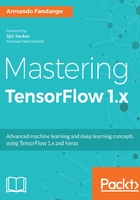
Summary
In this chapter, we did a quick recap of the TensorFlow library. We learned about the TensorFlow data model elements, such as constants, variables, and placeholders, that can be used to build TensorFlow computation graphs. We learned how to create Tensors from Python objects. Tensor objects can also be generated as specific values, sequences, or random valued distributions from various library functions available in TensorFlow.
The TensorFlow programming model consists of building and executing computation graphs. The computation graphs have nodes and edges. The nodes represent operations and edges represent tensors that transfer data from one node to another. We covered how to create and execute graphs, the order of execution, and how to execute graphs on different compute devices, such as GPU and CPU. We also learned the tool to visualize the TensorFlow computation graphs, TensorBoard.
In the next chapter, we will explore some of the high-level libraries that are built on top of TensorFlow and allow us to build the models quickly.